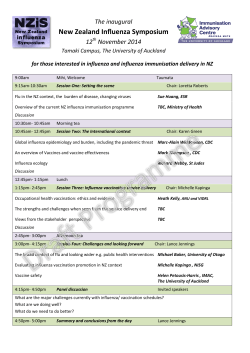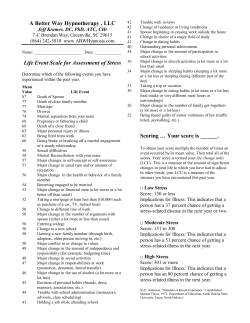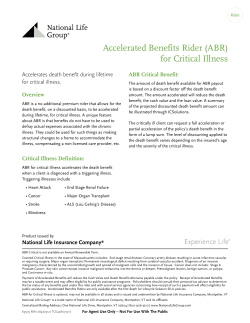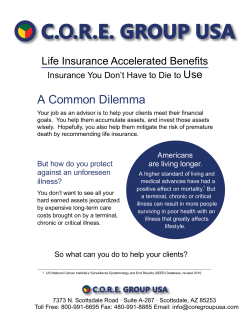
Influenza-Like Illness in Long-Term Care Facilities Toolkit Contents
Influenza-Like Illness in Long-Term Care Facilities Toolkit Contents 1. 2. 3. 4. CD Guidelines for Reporting Influenza-Like Illness Long-Term Care Facility Outbreak Management Respiratory Outbreak Prevention Additional Resources Other References (Included) Influenza-Like Illness Line List From NYC Department of Health and Mental Hygiene: Nasopharyngeal Specimen Collection for Viral Respiratory Pathogens: A Guide for Providers State Flu 2012-2013 Clinical Guidelines Lane County Public Health, Communicable Disease Program CD Guidelines for Reporting Influenza-Like Illness Are there two or more cases of influenza-like illness (cough, fever, sore throat, etc.)? Yes Has at least one been laboratory confirmed? No Continue observation for influenza-like illness and maintain prevention strategies. Seek laboratory confirmation if applicable. No Yes Call Communicable Disease at LCPH to report: Phone: (541) 682-4041 After Hours: (541) 998-4227 Facility Activities: Investigate ill residents/staff and record data using the Influenza-Like Illness Line List (See: Additional Resources) Continue daily surveillance of the facility and update the ILI Line List Fax the updated ILI Line List to LCPH daily: Fax: (541) 682-2455 Implement infection control measures (See: LTCF Outbreak Management) Determine vaccination status of residents/staff Communicate outbreak situation to staff and residents as appropriate Treat and/or implement prophylaxis to ill residents/staff as appropriate County Activities: Determine if an investigation is warranted Determine cause and course of the outbreak Implement control measures Document control of the outbreak 8/1/2013 Page 1 of 1 Lane County Public Health, Communicable Disease Program Long-Term Care Facility Outbreak Management Surveillance During flu season and periods of increased flu activity in the community, daily active surveillance for influenza-like illness should occur among all staff, new and current residents, and visitors. With a confirmed respiratory illness daily active surveillance should occur until at least one week after the last confirmed case occurred. Ill staff and visitors should be asked not to enter the facility. Testing Even when it is not flu season testing should occur when any resident has symptoms of influenza-like illness, especially when two more residents develop ILI within 72 hours of each other. Consider collecting vitals on all residents up to three times a day during outbreak situations. Determine the causative agent by performing tests on respiratory specimens (i.e. nasal swabs, throat swabs, nasopharyngeal swab, or nasopharyngeal or nasal aspirates). Implement Standard and Droplet Precautions for Ill Residents Perform hand hygiene before and after touching residents or their environment. Wear gloves if hand contact with respiratory secretions or contaminated surfaces will occur. Change gloves and perform hand hygiene after each resident encounter. Implement droplet precautions for residents with suspected or confirmed ILI for seven days after illness onset or until any fever and respiratory symptom has been gone for twenty-four hours. 8/1/2013 Page 1 of 2 Lane County Public Health, Communicable Disease Program Implement droplet precautions by placing ill residents in private rooms or cohorting the ill, wearing facemasks upon entering resident’s rooms, and asking ill residents to wear facemasks upon transport. Administer Antiviral Treatment or Prophylaxis All LTCF residents who have a suspected or confirmed ILI should receive antiviral treatment immediately, whether laboratory confirmation has been received or not. Once a respiratory outbreak has been established all eligible residents in the entire facility should receive antiviral chemoprophylaxis whether they have been vaccinated or not. Chemoprophylaxis may be considered for unvaccinated staff that provides care to residents at high risk for complications. Reduce Transmission Limit communal events, including closing the dining room for meal times. Place signs at the main entrance and throughout the facility alerting individuals to report ILI symptoms and encouraging visitors to visit at another time. Place hygiene materials throughout the facility, including gloves, masks, and hand sanitizer. Communication Communicate properly with staff about suspected or confirmed ILI residents, as well as updates about an outbreak situation as appropriate. Ask that ill staff, new residents, and visitors refrain from entering the facility until 24 hours after fever and ILI symptoms have ceased. Keep track of any new cases, ED visits, hospitals admissions, and/or deaths in the ILI Line List and update LCPH on a daily basis. 8/1/2013 Page 2 of 2 Lane County Public Health, Communicable Disease Program Respiratory Outbreak Prevention Vaccination Ensure that all eligible health care personnel and residents are vaccinated annually against influenza. Consider implementing an annual on-site influenza vaccine clinic for both residents and staff. Consider paying for, or reimbursing, staff vaccination to reduce staff illness, absenteeism, and transmission of respiratory illnesses. Determine new staff and resident admissions vaccination status and offer immunization if unvaccinated. Have data about resident and staff vaccination status available regardless of whether or not there is a respiratory outbreak. Non-Pharmaceutical Interventions Ask that any visitors exhibiting influenza-like illness symptoms save their visit for another time, regardless of whether or not it is flu season. Ensure that residents and staff are practicing proper hand hygiene before eating or touching the eyes, nose, and mouth and after coming in contact with respiratory secretions. Ensure that residents and staff are covering their nose and mouth with their elbows or a tissue, and throwing the tissue away afterwards. Keep tissues and proper hand hygiene items in resident’s rooms as well as throughout the facility. Clean and disinfect surfaces and objects that may be contaminated with flulike germs routinely. Consider enforcing flexible sick leave policies, as appropriate, to ensure that staff do not come to work when they are ill. 8/1/2013 Page 1 of 2 Lane County Public Health, Communicable Disease Program Communication Ensure that each resident’s primary care provider’s contact information is readily available in the event that a spontaneous outbreak may occur and antivirals need to be prescribed. If instead, a facility physician is assigned, contact them for antiviral treatment/prophylaxis for residents. Remain up-to-date on seasonal flu information from the CDC, Oregon State Public Health, as well as the community and LCPH. 8/1/2013 Page 2 of 2 Lane County Public Health, Communicable Disease Program Additional Resources Oregon State Public Health: Influenza and Influenza-like Illness Outbreaks in LTCFs: http://public.health.oregon.gov/DiseasesConditions/CommunicableDisease/Local HealthDepartments/Pages/ltcf.aspx Center for Disease Control: Healthcare-associated Infections in Long-Term Care Settings: http://www.cdc.gov/HAI/settings/ltc_settings.html Center for Disease Control: Prevention Strategies for Seasonal Influenza in Healthcare Settings: http://www.cdc.gov/flu/professionals/infectioncontrol/healthcaresettings.htm Center for Disease Control: Hand Hygiene in Healthcare Settings poster: http://www.cdc.gov/handhygiene/Basics.html Oregon Public Health Division: Disease Reporting for Clinicians poster: http://public.health.oregon.gov/diseasesconditions/communicabledisease/report ingcommunicabledisease/documents/2011_clinicianposter.pdf Oregon Public Health Division: Disease Reporting for Laboratories poster: http://public.health.oregon.gov/LaboratoryServices/ClinicalLaboratoryRegulation /Documents/poster.pdf Lane County Public Health: Communicable Disease Program: http://www.lanecounty.org/Departments/HHS/PubHlth/Pages/communicable_di sease.aspx 8/1/2013 Page 1 of 2 Lane County Public Health, Communicable Disease Program Oregon State Public Health: Reported Outbreaks in Long-term Care Facilities 2002-2013: http://public.health.oregon.gov/DiseasesConditions/CommunicableDisease/Outb reaks/Documents/LTCFoutbreaks.pdf Center for Disease Control: Seasonal Influenza: Cover Your Cough posters: http://www.cdc.gov/flu/protect/covercough.htm 8/1/2013 Page 2 of 2 Date: Facility: Facility contact: Investigator's name: Facility type (LTCF, etc.) Total No. Residents Total No. Staff Symptoms Name Fever >= Sore 100 F (1= Resident or Unit/ yes)*highest Cough throat Age Sex staff? Rm recorded temp (1=yes) (1=yes) For ILI/Influenza only Pneumonia (1=yes) Onset date ED visit? (1=yes) Hospitalized? (1=yes) Lab Vaccinated confirmed for influenza? influenza? Died? (1=yes) (1=yes) (1=yes) Other lab results (expl.: Comments (e.g. other symptoms, "adenovirus treated or prohylaxed +") w/antivirals, etc.) NASOPHARYNGEAL SPECIMEN COLLECTION FOR VIRAL RESPIRATORY PATHOGENS A Guide For Providers USE MASK, GLOVES, AND EYE PROTECTION NASOPHARYNGEAL ASPIRATE METHOD (PREFERRED) NASOPHARYNGEAL SWAB METHOD Materials: Materials: • Suction apparatus (Luken’s trap, syringe, or bulb) • Sterile suction catheter (e.g., #8 French) • Sterile saline • Viral transport medium tube • 1. Attach catheter to suction apparatus. 1. Bend shaft to follow curve of nasopharynx. 2. Instill several drops of sterile saline into each nostril. 2. Insert swab through nostril to posterior nasopharynx (same distance as from nostrils to external opening of ear). 3. Place catheter through nostril to posterior nasopharynx (same distance as from nostrils to external opening of ear). Nasopharyngeal swab (flexible shaft) with rayon tip • Viral transport medium tube 3. Rotate swab a few times to obtain infected cells. 4. Apply gentle suction. Using rotating motion, slowly withdraw catheter. 4. For an optimal sample, repeat procedure using other nostril. 5. For an optimal sample, repeat procedure using other nostril. 5. Place swab in transport medium. 6. With the viral transport medium, rinse secretions through the catheter into the collection container. 6. Bend or cut shaft to completely seal transport tube. TRANSPORT & STORAGE 1. Send specimen to lab immediately (testing sensitivity decreases over time). 2. Cool specimen to 2o - 4oC (36o - 40oF) during storage and transport. Incline patient’s head as shown. THE NEW YORK CITY DEPARTMENT of HEALTH and MENTAL HYGIENE Michael R. Bloomberg, Mayor Thomas R. Frieden, MD, MPH, Commissioner DIS1914201 – 1.06 70o Flu 2012-13 Clinical Guidelines Updated 10/7/2013 Definition of Influenza-Like Illness: fever > 100 F (37.8 C) plus cough and/or sore throat in absence of a known cause Infection Control Guidance: - hand hygiene (patient and staff) - respiratory hygiene (i.e. tissue, handkerchief, sneeze into sleeve) - surgical mask (patient and any staff within 6 feet) - staff surgical mask, gown, gloves, and eye protection in private inpt or outpt exam room - staff N-95 respirator, gown, gloves, an eye protection for any respiratory procedures Testing Options: Rapid Influenza A&B (low sensitivity 40-70% but high specificity ~90% – more accurate in kids > adults) If negative, cannot rule out influenza virus infection; If positive, likely a true positive Real-time RT-PCR test – most accurate & sensitive, order if/when: a. All hospitalized patients b. Negative Rapid when high community flu activity (and desired lab confirmation) c. Positive Rapid when low community prevalence (i.e. considering false positive) d. Close exposure to pigs, poultry, other animals with possibility of novel flu virus Treatment Overview Antivirals recommended as early as possible for any patient with confirmed or suspected influenza who: - Is hospitalized, or has severe, complicated, or progressive illness (if suspected flu, treat CAP w/ abx plus antivirals) - Is at higher risk for influenza complications as follows: Children younger than 2 years old (see note below) Adults 65 years and older; Medical conditions of chronic pulmonary (including asthma), cardiovascular (except hypertension), renal, hepatic, hematological (including sickle cell disease), neurological and neurodevelopmental conditions (including disorders of the brain, spinal cord, peripheral nerve, and muscle such as cerebral palsy, epilepsy [seizure disorders], stroke, intellectual disability [mental retardation], moderate to severe developmental delay, muscular dystrophy, or spinal cord injury); or metabolic disorders (including diabetes mellitus); Immunosuppression, including that caused by medications or by HIV infection; Women who are pregnant or post-partum (within two weeks after delivery); Persons younger than 19 years of age who are receiving long-term aspirin therapy; American Indians and Alaskan Natives; Persons who are morbidly obese (body-mass index ≥40); Residents of nursing homes and other chronic-care facilities. Antiviral treatment also can be considered for any previously healthy, non-high risk, symptomatic outpatient with confirmed or suspected influenza based upon clinical judgment, if treatment can be initiated within 48 hours of illness onset. Medication Treatment (5 days) Post-Exposure Chemoprophylaxis (7 days post exposure) Oseltamivir (Tamiflu) Adults 75-mg capsule twice per day 75-mg capsule once per day Children Age Weight < 1 yr -- 3 mg/kg/dose twice daily Not FDA Approved* > 1 yr < 15 kg 30 mg twice daily 30 mg once daily > 1 yr >15 to 23 kg 45 mg twice daily 45 mg once per day > 1 yr >23 kg to 40 kg 60 mg twice daily 60 mg once per day > 1 yr > 40 kg 75 mg twice daily 75 mg once per day Zanamivir (Relenza)** Adults 10 mg (two 5-mg inhalations) twice daily 10 mg (two 5-mg inhalations) once daily Children (≥7 years or older for treatment, ≥5 years for chemoprophylaxis) 10 mg (two 5-mg inhalations) twice daily 10 mg (two 5-mg inhalations) once daily *use in children ≥3 months and <1 yr old approved under EUA during the 2009 H1N1 pandemic; If child ≥3 months and <1 yr old, dose is 3 mg/kg/dose once per day. **Relenza not recommended for treatment or prophylaxis in patients with asthma or COPD due to risk of serious bronchospasm Flu 2012-13 Clinical Guidelines Updated 10/7/2013 Chemoprophylaxis (post-exposure vs. pre-exposure): antivirals are ~70% to 90% effective in preventing influenza and are useful adjuncts to influenza vaccination. 1. Persons at higher risk of influenza complications (see list), and - Influenza exposure without a vaccination history - Influenza exposure during first two weeks following vaccination 2. Immunosuppressed persons after exposure to influenza (regardless of vaccination) 3. Residents of institutions during confirmed or suspected influenza outbreaks - for control of outbreaks in long-term care facilities (e.g. elderly nursing homes) and hospitals, CDC recommends antiviral chemoprophylaxis for a minimum of 2 weeks, and continuing up to 1 week after the last known case was identified (and t/c PEP of unvax staff) *post-exposure chemoprophylaxis not generally recommended if > 48 hours since last contact with infectious person Duration of Isolation Precautions: - patients should stay out of school, work, or public until fever free x 24hrs without fever-reducing medicines - healthcare personnel should be excluded from work until fever free x 24hrs without the use of fever-reducing medicines Pregnancy & Up to Two Weeks Postpartum (including following pregnancy loss) - treat pregnant women with influenza-like illness ASAP with antiviral medications (best within 48hrs but still give later) - Oseltamivir (Tamiflu) preferred for treatment because of systemic activity (Pregnancy Category C) - benefits of treatment (& fever reduction) likely outweigh theoretical risks of antiviral use - drug of choice for chemoprophylaxis is less clear (alternative is early treatment based on signs and symptoms) Flu Vaccination (an A/California/7/2009(H1N1)-like virus; an A/Victoria/361/2011 (H3N2)-like virus; a B/Wisconsin/1/2010-like virus (from the B/Yamagata lineage) • • All persons aged 6 months and older should be vaccinated annually. High Risk persons for influenza-related complications should continue to be a focus when vaccine supply limited: o are aged 6 months--4 years (59 months) o are aged 50 years and older o have chronic pulmonary (including asthma), cardiovascular (except hypertension), renal, hepatic, neurologic, hematologic, or metabolic disorders (including diabetes mellitus) o are immunosuppressed (including immunosuppression caused by medications or HIV) o are or will be pregnant during the influenza season o are aged 6 months--18 years and receiving long-term aspirin therapy o are residents of nursing homes and other chronic-care facilities o are American Indians/Alaska Natives o are morbidly obese (body-mass index 40 or greater) o are health-care personnel o are household contacts and caregivers of children aged younger than 5 years and adults aged 50 years and older, with particular emphasis on vaccinating contacts of children aged younger than 6 months o are household contacts and caregivers of persons with medical conditions that put them at higher risk for severe complications from influenza. Children Ages 6mths- 8 Years Needing TWO Doses (spaced > 4weeks apart): • first ever flu vaccination or did not receive a total of 2 or more doses of seasonal influenza vaccine since July 1, 2010 Live Seasonal Flu Vaccine (LAIV) - approved for ages 2- 49 years who do NOT have the following Contraindications: - persons with a history of hypersensitivity, including anaphylaxis, to any of the components of LAIV or to eggs - children aged younger than 2 years (because of an increased risk for hospitalization and wheezing observed in clinical trials) - children aged 2--4 years with history of a wheezing episode during the preceding 12 months - persons with asthma - persons aged 50 years and older - have chronic pulmonary, cardiovascular (except hypertension), renal, hepatic, neurologic/neuromuscular, hematologic, or metabolic disorders - adults and children who have immunosuppression (including immunosuppression caused by medications or by HIV) - children or adolescents aged 6 months--18 years receiving aspirin or other salicylates - pregnant women *A moderate or severe illness with or without fever is a precaution for use of LAIV ** LAIV should not be administered to close contacts of immunosuppressed persons who require a protected environment Inactive Seasonal Flu Vaccine (TIV) Contraindications: -People who had a severe allergic reaction to eggs (h/o mild reaction to egg—that is, one which only involved hives—may receive TIV with addl precautions. -People who have ever had a severe allergic reaction to influenza vaccine. -People with a history of Guillain–Barré Syndrome that occurred after receiving influenza vaccine and who are not at risk for severe illness from influenza -People under 65 years of age should not receive the high-dose flu shot. -People who are under 18 years old or over 64 years old should not receive the intradermal flu shot. - Persons with moderate to severe acute febrile illness usually should not be vaccinated until their symptoms have abated.
© Copyright 2025





















